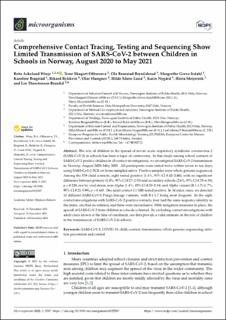Comprehensive contact tracing, testing and sequencing show limited transmission of sars‐cov‐2 between children in schools in norway, august 2020 to may 2021
Askeland Winje, Brita; Ofitserova, Trine Skogset; Brynildsrud, Ola Brønstad; Greve-Isdahl, Margrethe; Bragstad, Karoline; Rykkvin, Rikard; Hungnes, Olav; Lund, Hilde Marie; Nygård, Karin Maria; Meijerink, Hinta; Brandal, Lin Cathrine T.
Peer reviewed, Journal article
Published version
Permanent lenke
https://hdl.handle.net/11250/2986063Utgivelsesdato
2021Metadata
Vis full innførselSamlinger
Sammendrag
The role of children in the spread of severe acute respiratory syndrome coronavirus 2
(SARS-CoV-2) in schools has been a topic of controversy. In this study among school contacts of
SARS-CoV-2 positive children in 43 contact-investigations, we investigated SARS-CoV-2 transmission
in Norway, August 2020–May 2021. All participants were tested twice within seven to ten days,
using SARS-CoV-2 PCR on home-sampled saliva. Positive samples were whole genome sequenced.
Among the 559 child contacts, eight tested positive (1.4%, 95% CI 0.62–2.80), with no significant
difference between primary (1.0%, 95% CI 0.27–2.53) and secondary schools (2.6%, 95% CI 0.70–6.39),
p = 0.229, nor by viral strain, non-Alpha (1.4%, 95% CI 0.50–2.94) and Alpha variant (B.1.1.7) (1.7%,
95% CI 0.21–5.99), p = 0.665. One adult contact (1/100) tested positive. In 34 index cases, we detected
13 different SARS-CoV-2 Pango lineage variants, with B.1.1.7 being most frequent. In the eight
contact-investigations with SARS-CoV-2 positive contacts, four had the same sequence identity as
the index, one had no relation, and three were inconclusive. With mitigation measures in place, the
spread of SARS-CoV-2 from children in schools is limited. By excluding contact-investigations with
adult cases known at the time of enrolment, our data provide a valid estimate on the role of children
in the transmission of SARS-CoV-2 in schools.

